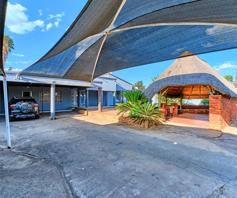A terrarium can be an attractive addition to almost any room, and they are fun and easy to make. Essentially, a terrarium comprises a glass container that encloses a miniature garden of small plants.

How does it work?
The majority of terrariums are completely sealed, and therefore they require very little or no care – you don’t even need to water them. So how do they work? All plants breathe, taking in sunlight and carbon dioxide, and through photosynthesis, they produce food for themselves and give off oxygen. Since terrariums are sealed, they become a kind of recycle plant, as the moisture in the soil condenses and turns back moisture that runs down the sides of the container, effectively watering the plants. There are terrariums that are not sealed, but these would require some watering because the water would escape through the container’s opening.

How to plant a terrarium
You will need a glass container, small stones, horticultural charcoal, potting soil, various plants of your choice, scissors, distilled water and decorative rocks and figurines.
Step 1: Thoroughly wash the glass container with very hot soapy water, rinse and dry completely. If possible, wash it in a dishwasher, as the heat will sterilise the glass.
Step 2: Insert a layer, approximately 2,5cm thick, of small stones on the bottom of the jar. Add about 1,5cm of charcoal on top of the stones. The purpose of the charcoal and the stones is to prevent mould forming in the soil, and to provide sufficient drainage so that the plants’ roots don’t sit in water and rot.
Step 3: Spoon in a 5cm to 8cm layer of potting soil. Try pile the soil higher on one side, to create a slight slope and make the plants more visible from a side view. Dig small holes for the various plants.

Step 4: Remove the plants from their pots, and shake off all the excess soil, and trim off all the damaged leaves. While the roots are still moist, place them in the holes and fill with potting soil. Pat the soil over the roots. Remember to place the taller plants at the back, and the smaller plants in the front. Once you are finished planting, you can place the moss over the soil as a form of groundcover.
Step 5: Dampen the soil with the distilled water. It is necessary to use distilled water, as our tap water contains lots of chemicals, such as chlorine and fluoride, which aren’t conducive to a healthy terrarium environment.
Step 6: Finally, it is time to decorate your miniature landscape with figurines, rocks, shells or any suitably small hardscaping element that takes your fancy.
Step 7: Place your terrarium in an area that receives a lots of light, but no direct sunlight, as this will cook and burn the plants. An area that is too dark and not light enough, will lead to the plants rotting.

Plants suitable for a terrarium
A wide variety of dwarf and baby plants are available at most nurseries – they are inexpensive to purchase and their small size makes them ideal for terrarium planting. When choosing your plants, make sure they do not require a dry environment, as a terrarium is very moist and will not meet the criteria. Moss and lichen are great options for terrariums, as are begonias, spider plants, small palms, miniature orchids, miniature ferns, African violets, baby tears, hepaticas, gloxinias and coleuses for example. Don’t choose plants with fuzzy leaves, as they tend to hold the moisture and will usually end up rotting in a closed environment.

Possible concerns
If you see too much moisture condensing on the sides of the terrarium, then just take the stopper off and let it breathe for a while. Over condensation often happens to newly planted terrariums, but things will soon settle down, and even though there will be some condensation, you will be able to clearly see the plants. – Antonella Desi
Pictures courtesy of:
Etsy: www.etsy.com.
Kay Elliot: www.katyelliott.com.
Matteo Cibic Studio: www.matteocibic.com.
Remodelista: www.remodelista.com.
The Fern & Mossery: www.thefernandmossery.com.
Readers' Comments Have a comment about this article? Email us now.








